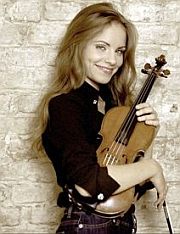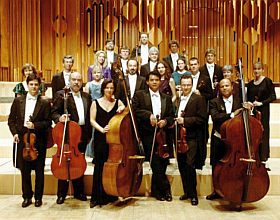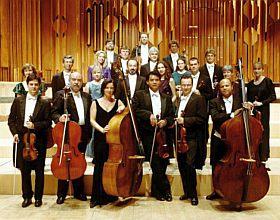We Bay Area concertgoers see a fair number of visiting soloists, but they tend to come playing with either our orchestras or their own accompanists. Violinist Julia Fischer has been here several times before — twice with the San Francisco Symphony, once with the St. Petersburg Philharmonic, once in recital, and always as the star attraction.

It says something for the confidence of the still-young (25) Fischer that on her current tour she’s leading an orchestra, the Academy of St. Martin-in-the-Fields, from the concertmaster’s chair more often than she’s playing concertos. On Saturday’s Cal Performances program at Berkeley’s Zellerbach Hall, the concertos were, indeed, fearsomely well played. But it was the rest of the program that delivered the knockout punch.
It was audacious of this lot to begin the program by playing the living daylights out of Benjamin Britten’s 1937 Variations on a Theme of Frank Bridge. If you have ever wondered why what’s generally acknowledged to be a major work by a major composer, not written for unreasonable forces, nonetheless seems never to be programmed by local ensembles (I don’t think it’s been played in the Bay Area in the last 10 years), the score has the key. The piece is just damned difficult. You could put it on a program together with “[Insert Orchestra Name Here] Presents the C-Major Scale,” and it would still eat up more rehearsal time than your budget could handle.
For the ASMF players, it was as a chunk of raw meat to a tiger. I fear that on this side of the Atlantic the ASMF has gotten a reputation for pretty blandness. At one time, the orchestra specialized in what seem to us (retrospectively) plush, genteel renditions of Baroque repertoire. More recently, the band has appeared here mainly as a deferential corporate accompanist to this or that soloist. Here they were at Zellerbach, in fact, on a tour promoting their young violinist/leader-of-the-moment, whose recent CD with them was on sale in the lobby. Were we to have the Bridge Variations as played by comfy cushions?
Nope. This performance was tight, passionate, and scalding hot even when (as it frequently was) the music itself was quiet and slow. The virtuosity of the toughest variations — the Wiener Walzer, the Moto Perpetuo, and the final fugue — was astonishing, but not more so than the incredible slow descent of the violins from the highest register near the end of the work. “Morendo” it is marked, and “morendo” (dying) it was, fading inch by calculated inch of bowstroke to a level of inaudibility I don’t think I’ve heard anyone else try to achieve in Zellerbach.
It was scarily good playing, as was everything else in the Britten. This is not a work anyone not deranged would ordinarily think of performing without a baton-waving conductor, but then you can’t generally assume you have an orchestra like this one, which breathes and bows as one almost without thinking. Even so, you have to make adjustments. (My husband caught one: a place at the end of the “Chant” variation where Fischer took, not the first part in the violin divisi, but the third, because that part is pizzicato and better for directing the rest of the orchestra.)
Sumptuous Walton

The Sonata for Strings, at the other end of the program, is an early-’70s orchestration, by the composer and Malcolm Arnold, of Walton’s String Quartet in A Minor of 1947. (Technically, as the program notes insist, it’s the “Second String Quartet,” the successor to a quartet written a quarter century earlier. The First Quartet garnered considerable attention for the young composer in the early ’20s, but it wasn’t actually published until decades later — posthumously? — and even now, if you want the parts or score, so far as I can tell you have to rent them.)
The parent quartet is a piece almost unheard here, though it’s a repertoire staple in Britain — one of those things most English quartets play regularly even if they don’t record. Why it never caught on here, I don’t know; there’s so much juicy stuff in there, beginning with the melancholy opening viola solo and ending with a jagged, syncopated finale that’s as likely an audience-pleaser as anything in the 20th-century quartet literature. The harmonies and the themes both have a cinematic sumptuousness that’s irresistible in the right hands. (It was the Hollywood String Quartet — first-chair players in studio orchestras, all — that made what I think was the first recording, in 1950.)
As an orchestral piece, the Sonata does sound like, well, an orchestrated string quartet. There’s the odd redistribution of voices, the occasional octave-doubling, and so forth, but basically this is just the Quartet, with lines divvied up between solo players and sections, and basses sometimes reinforcing the cellos. Even so, the orchestration changes the piece, sometimes for the better. There’s that fugato in the first movement, for instance: Somehow it fits more naturally into the piece with full string sections.
In between came the two Bach violin concertos — the music on Fischer and the ASMF’s new Decca disc, and presumably the commercial impetus behind this tour. If ever the meat of a sandwich were in danger of being obliterated by the bread, this would be the setup. If nothing else, it’s tough to make an impression as a soloist when on either side of your solos the entire violin section is playing parts much more exacting.
Fischer did, though. She has an uncannily pure sound and about the truest intonation I’ve ever heard. Moreover, she uses the bow with delightful freedom, romping from one end to the other at various speeds without any evident difference in the sound that comes out. That sounds trivial, but isn’t; to make a fast down-bow and a slow up-bow just afterward sound as though nothing has changed is a skill rare enough that most violinists try not to have to attempt it.
Mouths Agape
Fischer didn’t bother avoiding that sort of difficulty, probably because (so far as I could see) she didn’t feel it as one. The result was so smooth and effortless that I doubt most of the audience could tell that there was a difficulty being surmounted at all. I imagine you could have told which were the string players in the audience by looking for mouths agape.
The A-Minor Concerto, which came first, seemed a little light initially; the ASMF cellos and basses, careful not to lumber, sounded a bit as though they were walking on tiptoe. But the slow movement was exquisite, Fischer thinning down her line almost to nothing while the ritornello went on underneath, and the finale was exciting in a way that modern-instrument Bach too rarely is.
The E-Major Concerto, after intermission, was even finer. Fischer in the first movement was elegant and strong at once, but what struck me most there was the playing of the orchestra in the movement’s central section. How extremely cool, I thought, is that viola part, and why have I never noticed it before? (Possibly because it’s in an exceptionally nasty key, and there aren’t many viola sections in the world as certain of their intonation as this one.)
The slow movement began almost chastely, with next to no vibrato from anyone; toward the end it had become passionate in a way we’re now accustomed to think is almost indecorous in Bach, but without putting a foot wrong anywhere. And the finale was a triumph for orchestra and soloist alike — the latter for sailing through each episode with almost insolent ease, the former for managing, better than I’ve ever heard a modern-instrument orchestra do it, to make the ritornelli neither rushed nor stodgy, just eager and full of joy.
There was one encore: the last movement of Mozart’s early Divertimento K. 138, tossed off (again) with preposterous confidence. The entire piece features elsewhere in this tour, substituting for the Britten in markets where the latter is apparently a little too “modern.”

